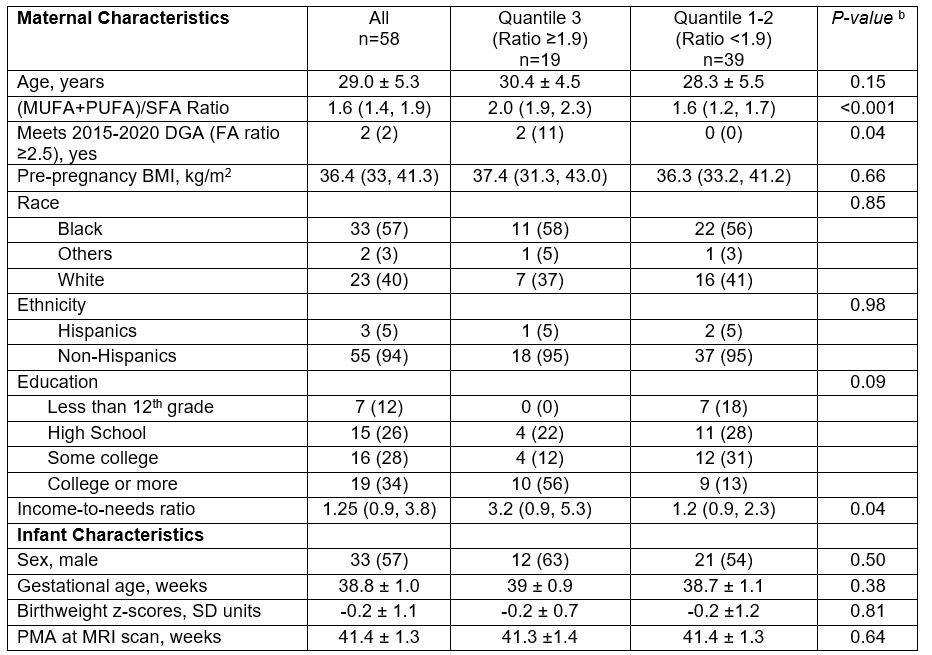Neurology: Neurodevelopment
Neonatal Neurology 5: Clinical
110 - A prenatal diet rich in unsaturated fatty acids and low in saturated fats is associated with higher regional grey matter volumes in infants born to mothers with pre-pregnancy obesity
Publication Number: 110.337

Carmen Monthe-Dreze, MD (she/her/hers)
Neonatologist/Instructor in Pediatrics
Brigham and Women's Hospital
Boston, Massachusetts, United States
Presenting Author(s)
Background:
Children exposed to maternal obesity (MatOb) in utero are at increased risk for neurodevelopmental disorders such as autism and attention deficit hyperactivity disorders. We recently showed that these newborns have lower thalami volume, a brain region important in supporting attention and regulatory control. Although prenatal dietary quality plays a key role in fetal brain development, it is unknown whether specific dietary fatty acid profiles in pregnancy may be protective in these newborns.
Objective: Determine associations of prenatal fatty acid profiles with regional gray matter volumes in newborns of mothers with obesity.
Design/Methods:
Subjects were from a longitudinal pre-birth cohort study (Early Life Adversity and Biologic Embedding) of mothers and their term infants who underwent brain magnetic resonance imaging (MRI). Analysis included neonates of mothers with pre-pregnancy obesity. Pregnancy exposure was the dietary history questionnaire-derived Healthy Eating Index fatty acids (HEIFA) profile, which indexes the ratio of unsaturated to saturated fats. We used multivariable regression to evaluate associations of HEIFA ratio (Q3 vs. Q1-2) with neonatal brain volumetrics, including regions we previously found to be reduced with MatOb. Confounders included maternal age, education, income-to-needs ratio, infant sex, and intracranial volume.
Results:
We included 58 mothers with pre-pregnancy obesity (60% non-White, median [IQR] BMI 36.4 kg/m2 [33, 41.3], and HEIFA Ratio 1.6 [1.4, 1.9]) and their term infants (57% male; mean [SD] gestational age 38.8 [1.0] wks, post menstrual age at MRI: 41.4 [1.3] wks, Table 1). In adjusted analysis, infants exposed to the highest tertile of prenatal HEIFA ratio (vs. Q1-2) had higher bilateral caudate (e.g., right: β, 205.6 mm3, CI: 45.7, 365.5), thalami (e.g., right: 184.9 mm3 [17.4, 352.4]) and total subcortical gray matter (SGM) volumes (Fig. 1). The associations of HEIFA ratio with caudate and SGM volumes were non-linear as depicted by natural cubic splines (Likelihood Ratio Test p< 0.05, Fig. 2); There was an increase in brain volumes for infants whose mothers’ AHEIFA ratio was in the top tertile (i.e ≥1.9); however, higher levels below Q3 did not confer additional benefit.
Conclusion(s):
Among neonates of mothers with pre-pregnancy obesity, higher dietary fat quality in pregnancy was associated with greater neonatal grey matter volumes in regions that play crucial role in cognition and emotional regulation. Future studies should investigate the benefits of prenatal dietary fatty acids as a target for optimal neurodevelopment in this vulnerable population.
.jpg)
.jpg)
